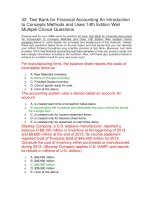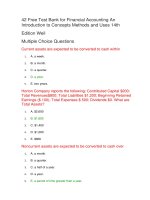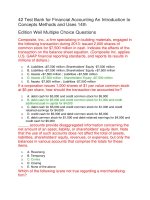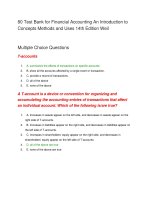Managerial accounting and introduction to concepts methods and user 11e by maher chapter 04
Bạn đang xem bản rút gọn của tài liệu. Xem và tải ngay bản đầy đủ của tài liệu tại đây (317.16 KB, 28 trang )
CHAPTER 4
Strategic
Management of
Costs, Quality, and
Time
PowerPoint Presentation by
LuAnn Bean
Professor of Accounting
Florida Institute of Technology
© 2012 Cengage Learning. All Rights Reserved. May
not be copied, scanned, or duplicated, in whole or in
part, except for use as permitted in a license
distributed with a certain product or service or
otherwise on a password-protected website for
classroom use.
Managerial Accounting 11E
Maher/Stickney/Weil
1
☼
CHAPTER GOAL
☼
This chapter illustrates the significance of
quality.
Prizes recognize improvements in quality.
Japan: Deming Prize
US: Baldrige Quality Award
International standards measure quality
ISO 9000: standards for quality management
ISO 14000: standards for communicating financial
impact of environmental issues
2
LO 1
TRADITIONAL VIEW
The traditional view of quality assumes that
improving quality always requires increasing
costs.
Firms can reduce total costs by
Producing lower-quality goods
Tolerating some level of defective goods
3
LO 1
QUALITY-BASED VIEW
The quality-based view holds that firms should
always attempt to improve quality.
Attempts to improve quality will succeed without
limit
Firms
Should not wait for inspections of finished products to
reveal defects
Must establish quality goals and procedures
Aim for zero defects
High quality pays for itself
4
Traditional View
Quality-based View
Quality increases costs
Quality decreases costs
Goods require inspection
Defect-free goods require no
inspection
Workers cause most defects
System causes most defects
Require standards, quotas, goals
Eliminate standards, quotas, goals
Buy from lowest cost supplier
Buy on basis of lowest total cost
Focus on short-run profits
Focus on long-run profits
EXHIBIT 4.1
TRADITIONAL VS. QUALITYBASED VIEW
LO 1
5
LO 2
QUALITY: Customer View
Three success factors to meet customer
requirements
Service
All the products features, tangible and intangible
Quality
Firm’s ability to deliver its service commitments
Cost
Customers will buy product that provides them with
preferred mix of quality, service, price
6
LO 2
VALUE CHAIN
Prevent quality
problems here
Design
Identify quality
problems here
Production
Marketing
Distribution
Deal with unhappy
customers here
Customer Service
EXHIBIT 4.3
Research and Development
7
LO 3
COSTS OF QUALITY
Prevention
Procurement inspection
Processing control
Design
Quality training
Machine inspection
Appraisal
End-process sampling
Field testing
8
LO 3
COSTS OF FAILING TO
IMPROVE QUALITY
Internal failure costs: detection before delivery
Scrap
Rework
Reinspection/retesting
External failure costs: detection after delivery
Warranty repairs
Product liability
Marketing costs
Lost sales
9
LO 4
EXAMPLE
Steve’s Sushi makes sushi for delivery only.
Steve has concerns about quality and so
he considers various ways he can
ensure/improve quality. He throws away
any prepared sushi that does not meet
strict quality standards. A quality report
follows.
Continued
10
LO 4
COST OF QUALITY REPORT:
Cost Categories
Costs of Quality % of Sales
Prevention Costs
Quality training
Materials inspection
$ 5,800
10,400
$ 16,200
1.62%
10,000
1.00
14,400
1.44
Customer complaints
3,000
0.30
Cost of lost business
17,000
1.70
Appraisal Costs
End-of-process sampling
Internal Failure Costs
Scrap
External Failure Costs
Total costs of quality
$ 60,000 6.06%
What
What
actions
actionscan
can
Steve
Steve
forego
foregoififhe
he
can’t
can’tdo
do
everything?
everything?
EXHIBIT 4.4
Steve’s Sushi
11
LO 4
Generally
Generallythere
thereisis
aalong-run
long-rundecline
decline
inintotal
totalcosts
costsof
of
quality
quality
EXHIBIT 4.5
12
LO 5
TOOLS
Tools to identify quality problems include
Control charts
Cause-and-effect analysis
Pareto charts
Produce signals about quality control
13
LO 5
SIGNAL:
SIGNAL: Definition
Definition
Is information provided to a decision
maker.
Warning signal indicates something is
wrong
Diagnostic signal suggests cause of
problem and possible solutions
14
LO 5
Control
Controlcharts
charts
distinguish
distinguish
between
betweenrandom
random
variations
variationsand
and
variations
variationstoto
investigate.
investigate.
EXHIBIT 4.6
15
LO 5
CAUSE
CAUSE and
and EFFECT:
EFFECT: Definition
Definition
Is analysis that first defines the
effect and then identifies the
cause.
16
LO 5
Pareto
Paretocharts
charts
illustrate
illustrate
graphically
graphicallythe
the
problems
problemsor
or
defects.
defects.
EXHIBIT 4.7
17
LO 6
JUST-IN-TIME:
JUST-IN-TIME: Definition
Definition
Is a philosophy that seeks to
purchase/produce goods and/or
services just when the company
needs them.
18
LO 6
JIT
Factors for success in JIT
Total quality
Smooth production flow
Purchasing quality materials
Well-trained, flexible workforce
Short customer-response times
Backlog of orders
19
LO 7
IMPORTANCE OF TIME
Success
Success in
in competitive
competitive markets
markets demands
demands
shorter
shorter new-product
new-product development
development time
time and
and
more
more rapid
rapid response
response to
to customers.
customers.
Customer
Customer response
response time
time is:
is: (1)
(1) newnewproduct
product development
development time
time and
and (2)
(2)
operational
operational measures
measures of
of time.
time.
20
LO 7
NEW-PRODUCT
NEW-PRODUCT DEVELOPMENT
DEVELOPMENT
TIME:
TIME: Definition
Definition
Refers to the period between a
firm’s first consideration of a
product and its delivery to the
customer.
21
LO 7
BREAK-EVEN TIME EQUATION
Break-even time =
(Investment ÷ Annual Discounted Cash Flow)
+
Time period from Project approval until Sales begin
22
LO 7
LIMITATIONS: Break-even Time
Break-even time
Ignores cash flows after break-even point
Does not consider strategic, nonfinancial reasons
for new product
Varies from one business to next, depending on
product life cycles and investment requirements.
23
LO 7
OPERATIONAL MEASURES
Indicate
Speed
Reliability
Customer response time
Delivery cycle time
Time from order to delivery
On-time performance
Delivered as scheduled
24
LO 8
BALANCED
BALANCED SCORECARD:
SCORECARD:
Definition
Definition
Reports an integrated group of
financial and nonfinancial
performance measures based on
vision and strategy.
25









